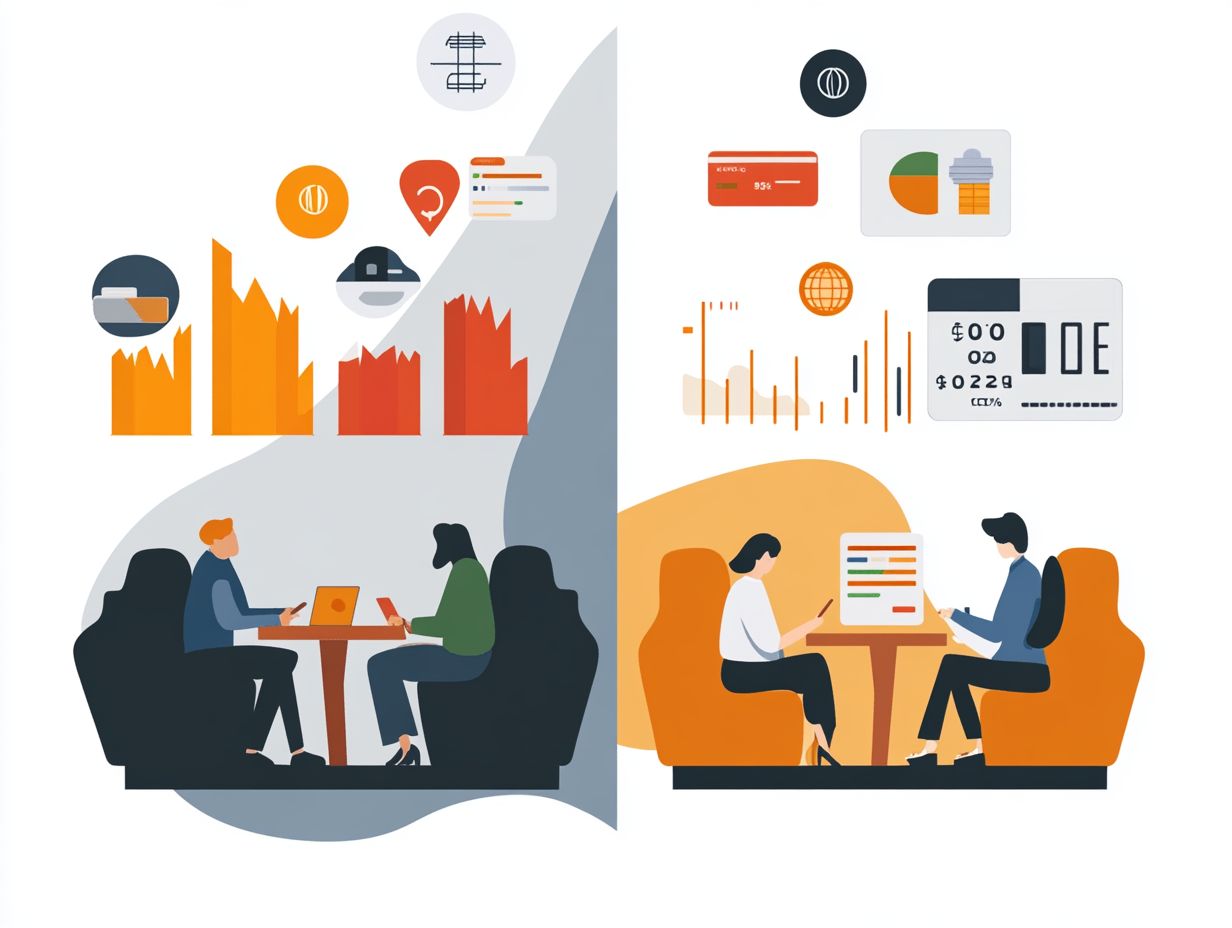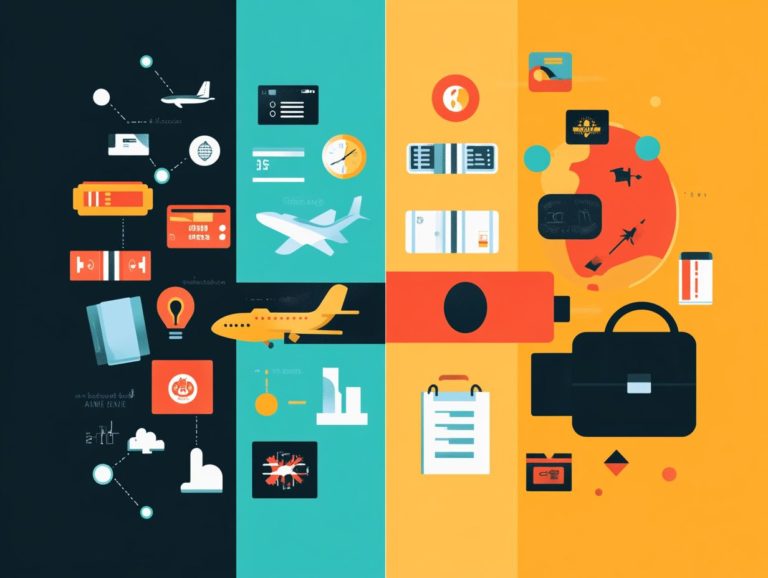Comparing Credit Card Usage Trends in 2024
As you navigate the evolving financial landscape, grasping credit card usage trends is essential for both consumers and businesses.
This article delves into the current state of credit card usage, illuminating the economic and technological factors that are shaping habits in 2024. You ll discover anticipated shifts in consumer behavior and the implications for credit card companies, along with effective strategies for adaptation.
You can look forward to a comparison of various credit card types, with a focus on rewards and benefits, while also picking up valuable tips to maximize your credit card experience. Dive in to stay informed and empower yourself to make smarter financial choices!
Contents
- Key Takeaways:
- Overview of Credit Card Usage Trends
- Factors Influencing Credit Card Usage in 2024
- Projected Changes in Credit Card Usage
- Impact on Credit Card Companies
- Comparing Different Types of Credit Cards
- Tips for Maximizing Credit Card Usage
- Frequently Asked Questions
- What are the predicted trends for credit card usage in 2024?
- How will credit card usage in 2024 differ from current trends?
- What could influence how we use credit cards in 2024?
- Will credit card rewards and benefits continue to be a significant factor in 2024?
- How can individuals prepare for potential changes in credit card usage in 2024?
- What are some potential benefits of increased credit card usage in 2024?
Key Takeaways:

- Credit card usage is expected to increase in 2024 due to economic and technological factors.
- Consumers are likely to shift towards using credit cards with better rewards and benefits.
- Credit card companies must adapt and innovate their strategies to stay competitive in the changing market.
Overview of Credit Card Usage Trends
The landscape of credit card usage has transformed significantly over the years. This showcases the shifting behaviors of consumers and the economic conditions that influence millions of Americans. Factors like average credit card balances and credit card debt statistics play a vital role in this evolution.
As you explore the trends in credit card usage, it s essential to grasp how various demographics, including state averages and economic conditions, affect not paying credit card bills on time and payment patterns. This ultimately shapes your experience as a cardholder.
The average APR is an important factor in guiding your choices and behaviors regarding credit cards.
Current State of Credit Card Usage
The current landscape of credit card usage in America reveals a nuanced interplay between consumer choice and financial necessity. Brands like American Express and Mastercard dominate the market, offering a diverse array of credit card options designed to meet various needs.
The average American now possesses about four credit cards, contributing to a staggering collective credit card debt exceeding $930 billion. Recent studies show that nearly 60% of cardholders carry a balance each month, underscoring the persistent challenge posed by high-interest rates that can amplify financial strain.
With payment patterns increasingly leaning towards credit especially among younger generations it becomes evident that there s a pressing need for financial literacy. Learning to manage expenditures effectively while staying informed about your credit limits and repayment strategies will be crucial for maintaining financial well-being.
Factors Influencing Credit Card Usage in 2024
As you step into 2024, several key factors are set to influence your credit card usage. Understanding the credit score trends will be essential, as economic and technological elements will play critical roles in shaping your financial decisions and preferences for credit card rewards.
It’s crucial to stay ahead of the rising credit card debt trend! You should explore alternative payment options like Buy Now Pay Later. This intricate interplay of factors highlights the evolving landscape you navigate when choosing credit cards, compelling you to adapt to new technologies and economic realities.
Economic and Technological Factors
Economic factors like interest rates and employment trends, coupled with technological advancements such as mobile payment systems, are profoundly shaping your relationship with credit card usage. These elements influence your financial choices and perceptions of credit card debt.
With interest rates in flux, you may find yourself re-evaluating your credit card habits, often gravitating toward higher interest options as borrowing becomes pricier. Concurrently, the rise of mobile payment solutions has streamlined transactions and fostered a tendency for impulsive spending among users.
As a result, you, particularly if you’re part of the younger demographic, might see credit cards as both a convenient tool and a potential financial burden. This duality shapes your mindset, leading you to adopt a cautious stance on accumulating debt while simultaneously embracing the advantages that modern technology offers for everyday purchases.
Projected Changes in Credit Card Usage

The anticipated changes in credit card usage over the coming years signal a noteworthy shift in consumer behavior. This evolution is shaped by fluctuating credit card debt levels and the ever-changing financial landscapes, especially with options like travel credit cards: what to look for in 2024, that influence how individuals interact with credit card payments and rewards.
As the economy changes, it s time to rethink how you use your credit cards. Your approach to utilizing credit cards will evolve, necessitating a deeper understanding of these emerging trends.
Expected Shifts in Consumer Behavior
Changes in how we use credit cards show that you re becoming more strategic in your spending. You re focusing on getting the most rewards while being careful about potential pitfalls.
As the economy shifts, like other savvy consumers, you re assessing how your spending aligns with the perks of different credit cards. Look for sign-up bonuses, cashback offers, and travel rewards that enhance your purchasing power.
To avoid overspending, it s essential to adopt effective debt management techniques. Poor budgeting and unexpected expenses can lead to delinquency, which is increasingly concerning.
By maintaining a clear budget and regularly reviewing your account statements, you can navigate your financial landscape and ensure that your credit card usage remains a valuable asset.
Impact on Credit Card Companies
The evolving trends in credit card usage and consumer behavior are profoundly impacting credit card companies. They must adapt their strategies to align with the shifting financial landscape and the rising prevalence of credit card debt among users.
In this competitive environment, enhancing credit card rewards programs is essential for attracting and retaining customers. These companies must continually innovate to meet the demands and preferences of consumers, ensuring they remain relevant and appealing.
Strategies for Adapting to Changing Trends
To effectively navigate the shifting trends, credit card companies are crafting innovative strategies tailored to your preferences, especially regarding credit card rewards and managing debt.
They re refining the allure of their rewards programs with more flexibility and higher earning potential. Companies know what their customers want and are responding with features like customizable rewards categories and enhanced cash-back options.
They’re also proactively offering financial education resources and tools to help you manage your expenses, fostering a sense of trust and loyalty.
By actively listening to your feedback, these companies are positioning themselves to stay competitive in a dynamic marketplace.
Comparing Different Types of Credit Cards
When comparing various types of credit cards, it’s crucial for you to assess their distinct rewards, fees, and benefits. These elements play a significant role in shaping your overall satisfaction as a credit cardholder.
This consideration is particularly important across diverse demographics, including Gen Z and Baby Boomers, who may have different preferences and priorities.
Rewards, Fees, and Benefits

Rewards, fees, and benefits are essential components of credit cards that draw you in and significantly influence your overall financial health. They are particularly important when managing credit card debt effectively.
These factors play a pivotal role in shaping your preferences and guiding your choices in the competitive credit card landscape. For example, a card offering substantial cashback rewards might tempt you to spend more, using that incentive to pay off your balances sooner.
On the flip side, high annual fees can make you pause and evaluate the long-term value of rewards against immediate costs. Statistics reveal that about 37% of credit card users switch cards mainly for better reward programs, underscoring how these benefits can sway financial decisions.
Grasping these elements is crucial as you navigate your financial journey with wisdom.
Tips for Maximizing Credit Card Usage
To truly maximize your credit card usage, embrace best practices that elevate the advantages of credit card rewards while ensuring you make timely payments.
This approach fosters wise financial decisions and helps minimize the risk of accumulating unwanted debt.
Best Practices for Responsible and Beneficial Usage
Implementing best practices for responsible credit card usage is essential for maintaining your financial health. This enables you to make informed decisions, helping to reduce credit card debt while maximizing rewards and benefits.
Understanding the details about interest rates is crucial; it gives you the power to sidestep costly pitfalls. By paying off your balances in full each month, you can prevent interest from piling up, protecting your credit score and overall financial well-being.
When used wisely, rewards credit cards can unlock valuable perks. This requires a responsible approach, such as establishing a budget and adhering to it to minimize the risks of spending too much.
Consider utilizing alerts for payment due dates to ensure you make timely payments. This builds a great credit history that opens doors for future opportunities!
Frequently Asked Questions
What are the predicted trends for credit card usage in 2024?
According to reference data, credit card usage is expected to continue to rise in 2024, with more consumers relying on credit cards for their purchases. For those looking for the best options, check out the top 5 credit card offers compared for 2024.
How will credit card usage in 2024 differ from current trends?

The usage of contactless payments is expected to significantly increase in 2024, as more consumers become comfortable with this technology. This may decrease the use of physical credit cards in favor of digital payments.
What could influence how we use credit cards in 2024?
Economic conditions, changes in consumer behavior, and advancements in technology could all play a role in shaping credit card usage trends in 2024.
Will credit card rewards and benefits continue to be a significant factor in 2024?
It is likely that credit card companies will continue to offer attractive rewards and benefits to attract and retain customers in 2024. However, the specific types of rewards and benefits offered may evolve to meet changing consumer needs and preferences.
How can individuals prepare for potential changes in credit card usage in 2024?
Staying informed about new credit card technology and features, regularly monitoring credit card statements and balances, and practicing responsible credit card use can help individuals prepare for potential changes in credit card usage, such as those outlined in the top 5 business credit cards compared for 2024.
What are some potential benefits of increased credit card usage in 2024?
Increased credit card usage may lead to greater convenience and security for both consumers and businesses, as well as potentially providing more opportunities for credit card rewards and benefits.
Start implementing these tips today to boost your credit card benefits!






